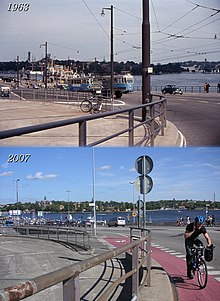| Public transportation in Sweden | |
|---|---|
 | |
| Overview | |
| Transit type | Air, rail, road, water |
Transport in Sweden is available for all four main modes of transport—air, bus, ferry and rail[1]—assisting residents and visitors without their own vehicle to travel around much of Sweden's 450,295 square kilometres (173,860 sq mi).
|
Main article: Rail transport in Sweden |
Rail transport is operated by SJ, DSBFirst, Green Cargo, Vy Tåg and more.[2] Most counties have companies that provide ticketing, marketing and financing of local passenger rail, but the actual operation is undertaken by the aforementioned companies. There is 11,663 km of railway, of which 9,227 km is nationalised and 3,594 km is county-owned. As of 2008, over 11,000 km of rails are 1,435 mm (4 ft 8+1⁄2 in) guage, of which 7,531 km is electrified. There are 65 km of 891 mm (2 ft 11+3⁄32 in) guage.
Trains generally keep to the left, as opposed to all neighbouring countries.
Stockholm Metro (Stockholms tunnelbana) is the only metro system in Sweden.
Cities with light rail (trams);
Stockholm previously had a large tram network, but this was discontinued in favour of bus and metro; a revival of the tram network was seen in the construction of Tvärbanan in the late 1990s and early 2000s.
|
See also: Trams in Europe |

Sweden has right-hand traffic today, like all its neighbours.
Sweden had left-hand traffic (Vänstertrafik in Swedish) from approximately 1736 and continued to do so until 1967. Despite this virtually all cars in Sweden were actually left-hand drive and the neighbouring Nordic countries already drove on the right, leading to mistakes by visitors. The Swedish voters rejected a change to driving on the right in a referendum held in 1955.
Nevertheless, in 1963 the Riksdag passed legislation ordering the switch to right-hand traffic. The changeover took place on a Sunday morning at 5am on September 3, 1967, which was known in Swedish as Dagen H (H-Day), the 'H' standing for Högertrafik or right-hand traffic.
Since Swedish cars were left-hand drive, experts had suggested that changing to driving on the right would reduce accidents, because drivers would have a better view of the road ahead. Indeed, fatal car-to-car and car-to-pedestrian accidents did drop sharply as a result. This was likely due to drivers initially being more careful and because of the initially very low speed limits, since accident rates soon returned to nearly the same as earlier.
Total roadways: 572,900 km, as of 2009.
Motorways run through Sweden, Denmark and over the Öresund Bridge to Stockholm, Gothenburg, Uppsala and Uddevalla. The system of motorways is still being extended. The longest continuous motorways are Värnamo–Gävle (E4; 585 km) and the Norwegian border–Vellinge (E6; 482 km; as the motorway between Trelleborg and Oslo in Norway has been completed in 2015).
There are 2,052 kilometres (1,275 mi) of waterways in Sweden.
There are 19 ports which are navigable to small steamers and barges.
|
See also: Swedish Civil Aviation Administration and List of airports in Sweden |
In 2012, there were 230 airports in Sweden. Of these, 149 have paved runways, with three (Stockholm Arlanda, Göteborg Landvetter and Luleå) being over 3,047 metres (9,997 ft) long. There are over eighty airports with unpaved runways. A large number of war-time airfields exist in various lengths, usually built into roads, and are usually less than 1,000 metres (3,300 ft) long.
Every hospital, airport and military base has a helipad.